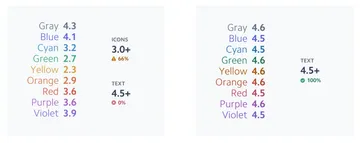Web Accessibility: An Overview for Businesses and Consultants

Mariel de la Garza, Former Developer
Article Categories:
Posted on
Making websites accessible can reduce legal liability, increase positive brand perception, increase the number users and customers, and even improve SEO. Accessibility isn't just good for users - it's good for business.
Before becoming a software engineer, I worked as an attorney and a public policy consultant. Web accessibility is right at the intersection of my interest in law, public policy, and tech. Unfortunately, many view accessibility as an "extra" or something that can be prioritized later.
Accessibility is something that should be exciting and its benefits can impact every aspect of a business! By tackling digital accessibility, a business can increase its reach, improve its search engine optimization, reduce legal liability, and increase goodwill. Below is an overview of what accessibility means, the benefits of prioritizing it, and the costs of ignoring it.
What is "accessibility"? #
At a fundamental level, something is accessible when anyone can use it without receiving assistance.
As an example, sidewalk ramps are great. Whether someone is using a wheelchair or pulling a suitcase, they make it easy to go between the sidewalk and the street. But, if we want the ramp to be usable by anyone, we also need to account for users who may not be able to see. The ADA guide for ramps and curb ramps talks about using “detectable warnings,” which are bumpy strips of concrete where the ramp meets the street. These warnings allow someone relying on a cane to tell that they’re approaching where vehicles cross. The result is that the ramp does not require additional work by anyone. (That would be an accommodation, not accessibility, and the two are very different.)
When it comes to the digital experience the same principle applies. A website is accessible when anyone can use it, including users experiencing situational limitations. Someone who can’t see may be blind or they may have their field of view obstructed by something or they may be dealing with screaming children and aren't able to look at a screen at the moment. Someone with limited mobility may only have one arm or they may have an arm in a sling while it heals from an injury or they may be carrying an object or child and only have one free hand at that moment. If a website cannot be used by anyone regardless of their ability to see, hear, move, or speak, or whether they have cognitive or neurological disabilities, then it is not accessible.
Today, our world is run by the internet. It’s where news is, business happens, and users are.
Why we should care #
Reduced legal liability #
No business wants to risk being sued or paying legal fees. It has been estimated that addressing one accessibility complaint can cost as much as $10,000, and the defense and settlement of one lawsuit as much as $350,000. Below, we'll see that the number of disability lawsuits has increased over 1,100% since 2016 and continues to rise. Failure to follow accessibility laws puts your business at risk.
Good will is good for business #
The way people feel about your business matters. In a 2020 whitepaper, Kantar, a data-driven consulting firm, found that “60 percent of consumers under 30 prefer brands that “have a point of view and stand for something.” In November 2020, Edelman, the global communications firm, published a report stating that: [b]rands are expected to solve both societal and personal problems, [including] proper treatment of employees and making the product [domestically].
Brands that stand for something see the benefits. In 2018, Nike’s ad campaign featuring Colin Kaepernick led to shares hitting a record high and their market value rising by $6 billion. Patagonia, a company that is known for its activism and commitment to sustainability is able to donate “1% of their sales to grassroots environmental organizations (approximately $20MM annually),” which puts their sales at $2 billion.
A better user experience means more users #
The CDC estimates that 1 in 4 American adults is living with a disability, and. The National Institutes of Health has said that “blindness cases in the U.S. [are] expected to double by 2050.” More and more customers are going to require or benefit from accessible websites. While accessibility doesn’t guarantee a business will reach every potential customers, it does guarantee that those customers and their $13 trillion in disposable income are not shut out from the beginning.
One example of increased user reach: In 2011, the popular NPR show This American Life “embarked on a project to transcribe their entire audio archive and make transcripts freely available to website visitors”. Transcripts are an accessibility improvement, both for users who are not able to hear and users who are in situations where playing audio may be inconvenient or inappropriate. This change led to a 4.36% increase in inbound traffic, a 6.68% increase in search traffic, and a 3.89% increase in inbound links.
It affects SEO, which affects product reach #
Search Engine Optimization is what determines whether a website comes up when someone is told to “just Google it.” A search engine reads a website the same way a screen-reader user would. So when you follow accessibility best practices, like descriptive text for links, legible font sizes, appropriately sized tap targets for mobile users, you're strengthening your SEO.
It may reduce long-term costs #
In addition to future-proofing against legal complaints and lawyers’ fees, making a site accessible may save costs by cutting down on: server load, maintenance costs, the need for alternative formats (large print, braille), translation costs, and customer service costs.
The web is for everyone #
Google says it most clearly: Everyone should be able to access and enjoy the web.
Why we must care #
The Americans with Disabilities Act
The Americans with Disabilities Act (ADA) is civil rights legislation meant to ensure people with disabilities “have the same opportunities as everyone else to participate in the mainstream of American life. . . .” The ADA is what requires a business to have a ramp to its entrance, or an extra wide bathroom stall, or captions on its video materials.
Does the ADA apply to websites? Maybe. Probably. #
In 2018, the DOJ submitted a letter to Congress stating its opinion that the ADA does apply to websites, and that the absence of specific regulations isn’t a basis for noncompliance with a statute. In 2019, website accessibility became big news when a Title III case against Domino’s reached the U.S. Supreme Court (SCOTUS) and asked: does the ADA require a private business offering its goods and services to the public to make its websites and apps accessible?
While SCOTUS did not ultimately answer that question, the appellate court that heard the case gave a thorough discussion of the issue, making the important distinction that Title III’s requirements “appl[y] to the services of a place of public accommodation, not services in a place of public accommodation.” (emphasis added) That is, the ADA obligation does not end at the company’s doorstep.
Whether the ADA applies to websites may not be settled law, but that doesn’t mean Congress isn’t thinking about it. In 2020, H.R. 8478, the “Online Accessibility Act” was introduced by Rep. Ted Budd (R-NC-13) and cosponsored by Rep. Luis Correa (D-CA-46). Ultimately, it didn’t go anywhere, but what’s important for us is this: the law could change at any time, and it’s less expensive to be ready from the beginning.
Courts are working on it #
While only a licensed attorney can provide advice about any laws and their application to a specific situation, we can look at the numbers. In the first half of 2021, “lawsuits alleging websites, apps, and digital videos were inaccessible … rose 64%” from a year earlier. From 2016 to 2020, there was a 1,100% increase in the number of lawsuits filed. Accessibility is something people care about and are willing to pay to have enforced.
Dismissals are not free #
Many of the suits brought over website accessibility result in dismissals after a settlement is reached. As part of these settlements, businesses are often required to update their websites per the Web Content Accessibility Guidelines. The cost of that update is on top of any related legal fees incurred by defending the case to begin with. We saw above that defending and settling an ADA lawsuit alone can cost hundreds of thousands of dollars.
Or, rather than spending hundreds of thousands, a business could wind up like Target. In 2006, Target was ordered to establish a $6 million dollar settlement fund and pay $3.7 million in attorney’s fees, in addition to agreeing to update their website and corporate policies.
What does this mean for consultants? #
As consultants, our job is to provide expert, informed opinions in our area of expertise and guide clients toward a path that lets them accomplish their goals in the best possible way. Clients are made up of people, and their priorities will be just as varied. We must be able to give them the information they need in order to properly evaluate what path forward aligns most with their business priorities and values. We can only do this by making sure we stay up to date with changes in design, development, and accessibility requirements.
What accessibility doesn't mean #
We also need to be able to explain what accessibility doesn’t mean. A common misconception is that making a website accessible will mean sacrificing the design or “feel” of it. Stripe, a popular payment processing company, wrote a thorough post about how they updated their color system to keep its vibrancy, but make it accessible. In the screenshot below, you can see Stripe's colors before and after the update.

At Viget, we’ve seen how accessible design might require us to think a little differently but still have beautiful results. Jeremy Fields, our Front-End Development Director, has previously pointed out that: “There's no technical reason why [beautiful, cutting-edge experiences] couldn't be accessible.”
Beginning is Better #
Our responsibility to clients is to make it clear that building in accessibility from the beginning is just better. We need to be able to explain why it will cost less and why we can implement basic accessibility easily - that we are experienced professionals who build accessibility into our practice.
We need to be aware of choices like accessibility overlays, and be ready to explain why they aren’t better options: they aren’t a guarantee against lawsuits, they don’t guarantee successful defense once sued, and instead of paying once when the site is built, users are locked into paying the provider of the overlay for as long as they use the service. Some of these sites themselves are not accessible, which shouldn’t instill confidence. On top of that, disabled users have said these overlays can make the experience worse.
Empathy and Education #
Part of consulting is educating, and then accepting a client’s decision. If we have provided our expert opinion based on the most up-to-date information that we have, we have to trust the client to evaluate that opinion against their internal costs and values. A “no” on something today could turn into a “yes” next week if the client has been given enough to chew on and has been respected in the process.
What does this mean for businesses? #
With millions of websites out there, 4,000 lawsuits in one year may seem low, but to take no action is to bet that no one will ever sue, or that the company will have the funds to withstand a suit when it comes. That calculus assumes that the landscape will remain static, when we know that the number of web users is only going to continue to grow. Investing in accessibility is an investment in the future of the web, the future of business, and the success that comes from being on the cutting edge of both.